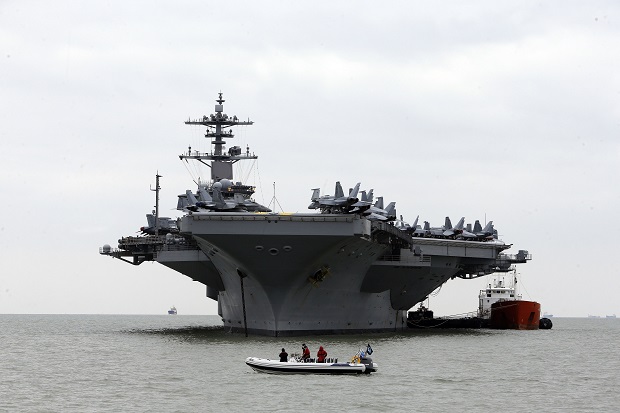
The US aircraft carrier USS Theodore Roosevelt, at anchor off the United Kingdom’s south coast Monday March 23, 2015, as it is too big to enter one of the Royal Navy’s major bases, the carrier, one of ten Nimitz class aircraft carriers in the US fleet, arrived at Portsmouth, England Sunday for a five-day visit. The 100,000-ton ship, nicknamed Big Stick, is steaming toward the waters off the country to beef up security and join other American ships that are prepared to intercept any Iranian vessels carrying weapons to the Houthi rebels. AP
WASHINGTON, United States — The Navy aircraft carrier, USS Theodore Roosevelt is steaming toward the waters off the country to beef up security and join other American ships that are prepared to intercept any Iranian vessels carrying weapons to the Houthi rebels.
The deployment comes after a U.N. Security Council resolution approved last week imposed an arms embargo on the leaders of the Iranian-backed Shiite Houthi rebels. The resolution passed in a 14-0 vote with Russia abstaining.
In this picture taken on Tuesday, April 7, 2015, and released by the semi-official Fars News Agency, Iranian warship Alborz, foreground, prepares before leaving Iran’s waters. Iran dispatched a naval destroyer and another logistic vessel, Wednesday to waters near Yemen as the United States quickened weapons supply to the Saudi-led coalition striking rebels there, underlining how foreign powers are deepening their involvement in the conflict. Iran’s English-language state broadcaster Press TV quoted Rear Adm. Habibollah Sayyari as saying the ships would be part of an anti-piracy campaign “safeguarding naval routes for vessels in the region.” AP
Navy officials said Monday that the Roosevelt was moving through the Arabian Sea. A massive ship that carries F/A-18 fighter jets, the Roosevelt is seen more of a deterrent and show of force in the region.
READ: ‘Rebel-supporter’ Iran sends warship to Yemen, raising stakes
The Navy has been beefing up its presence in the Gulf of Aden and the southern Arabian Sea in response to reports that a convoy of about eight Iranian ships is heading toward Yemen and possibly carrying arms for the Houthis. Navy officials said there are about nine U.S. warships in the region, including cruisers and destroyers carrying teams that can board and search other vessels.
Yemen, the Arab world’s poorest country, has been pushed to the brink of collapse by ground fighting and the Saudi-led airstrikes in support of current President Abed Rabbo Mansour Hadi, who was forced to flee to Saudi Arabia. Observers say the fighting in the strategic Mideast nation is taking on the appearance of a proxy war between Iran, the Shiite powerhouse backing the Houthis, and Sunni-dominated Saudi Arabia.
READ: DFA pleads to Filipinos in Yemen: Come home, conflict to worsen
The officials spoke on condition of anonymity because they were not authorized to discuss the ship movement on the record.
Saudi Arabia and several of its allies, mainly Gulf Arab countries, have been trying to drive back the rebels, who seized the capital of Sanaa in September and have overrun many other northern provinces with the help of security forces loyal to former President Ali Abdullah Saleh. The U.S. supports the Saudi campaign.
Western governments and Sunni Arab countries say the Houthis get their arms from Iran. Tehran and the rebels deny that, although the Islamic Republic has provided political and humanitarian support to the Shiite group.
The U.S. has been providing logistical and intelligence support to the Saudi coalition launching airstrikes against the Houthis. That air campaign is now in its fourth week, and the U.S. has also begun refueling coalition aircraft involved in the conflict.
White House spokesman Josh Earnest would not comment specifically on any Navy movements in Yemeni waters, but said the U.S. has concerns about Iran’s “continued support for the Houthis.
“We have seen evidence that the Iranians are supplying weapons and other armed support to the Houthis in Yemen. That support will only contribute to greater violence in that country. These are exactly the kind of destabilizing activities that we have in mind when we raise concerns about Iran’s destabilizing activities in the Middle East.”
He said “the Iranians are acutely aware of our concerns for their continued support of the Houthis by sending them large shipments of weapons.”
The expanded U.S. Navy activity in the region comes at a sensitive time, as the U.S. and six world powers have reached a framework deal with Iran to control its nuclear program. Since the preliminary deal with reached on April 2, Iran and the U.S. have been disputing the details of the deal. And on Monday, a lawyer for Tehran-based Washington Post reporter Jason Rezaian said Tehran had charged Rezaian with espionage and three other crimes. The Obama administration dismisses the charges as “absurd.”
RELATED STORIES
Obama vows to address Iran’s ‘destabilizing’ role in Mideast
Why It Matters: The Saudi-led intervention in Yemen